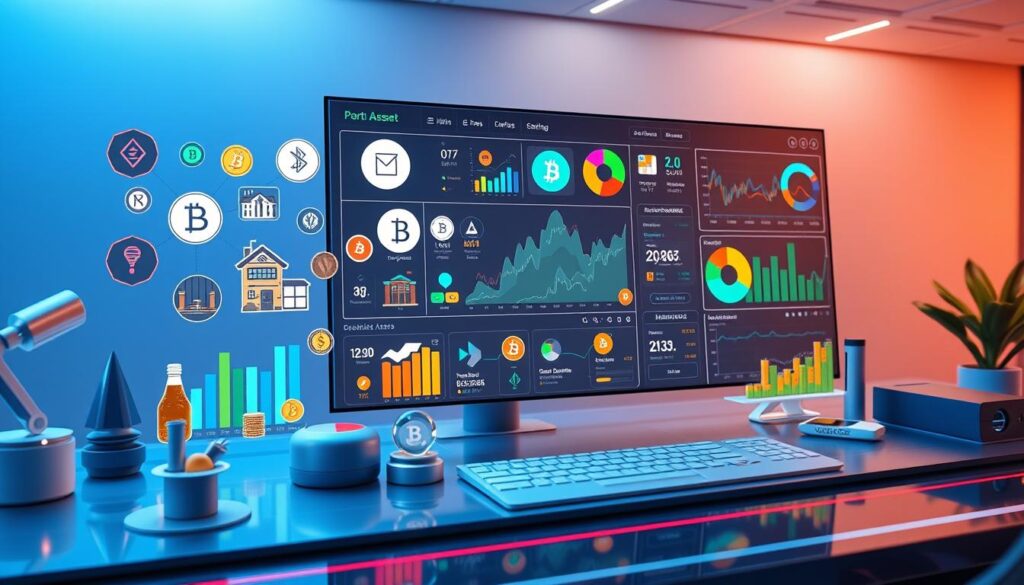Tokenized Assets: Diversifying Your Portfolio Beyond Bitcoin

Exploring cryptocurrency investments, I wonder: can tokenized assets make our portfolios more stable and diverse? Or are they just a short-lived trend? Tokenized assets, which turn traditional assets like real estate or commodities into digital forms using blockchain, seem promising.

Investing in tokenized assets lets people explore a variety of assets. This way, they don’t rely too much on Bitcoin. I’m intrigued by the idea of diversifying our portfolios with tokenized assets in the cryptocurrency world.
Key Takeaways
- Tokenized assets offer a way to diversify your portfolio beyond Bitcoin
- They represent traditional assets in a digital format using blockchain technology
- Diversifying your portfolio can reduce reliance on a single asset class
- Tokenized assets can provide exposure to a wide range of assets
- They are a key component of cryptocurrency investments
- Diversifying your portfolio with tokenized assets can lead to a more stable portfolio
My Journey from Bitcoin Maximalist to Diversified Investor
As I explored the world of cryptocurrency, I learned the value of diversifying my portfolio beyond bitcoin. Tokenized assets showed me how to spread risk and maybe earn more. I looked into digital tokens, from asset tokens to security and utility tokens.
My path wasn’t easy, but I wanted to grasp cryptocurrency’s full potential. I found that beyond bitcoin, many tokenized assets could help diversify my investments.
Why I Started Looking Beyond Bitcoin
I looked beyond bitcoin because of its scalability and usability limits. High fees and slow processing were big drawbacks. Other digital tokens offered quicker and cheaper transactions, better for everyday use.
The Limitations I Found in Bitcoin-Only Investing
Investing only in bitcoin narrowed my market exposure. By adding tokenized assets to my portfolio, I opened up new chances and reduced bitcoin’s volatility risks.
My First Steps into Tokenized Assets
I started by researching digital tokens like asset, security, and utility tokens. Each has its own use and benefits. This knowledge helped me pick the right assets for my portfolio.
By venturing beyond bitcoin and into tokenized assets, I built a more varied and stable portfolio. Tokenized assets have been key in reaching my investment goals.
Understanding the Basics of Tokenized Assets
Tokenized assets are digital versions of real things like property or gold. They live on a blockchain, which keeps everything safe and clear. This is better than old ways because it’s more secure and open.
Creating these digital assets uses blockchain. It lets us make and handle digital tokens. These tokens can be anything from property to art. This makes it easier for people to invest and trade.
Some big pluses of tokenized assets are:
- They’re safer and clearer thanks to blockchain.
- They make it easier to buy and sell things.
- They cut down costs and make things more efficient.
Tokenized assets are changing finance. They offer a safe, clear way to invest. This helps people spread out their money and reach their goals.
Blockchain is key to tokenized assets. It keeps digital tokens safe and open. As more people use these assets, we’ll see even more cool blockchain uses in finance.
| Asset Type | Tokenized Asset Example |
|---|---|
| Real Estate | Tokenized real estate investment trusts (REITs) |
| Commodities | Tokenized gold or oil |
| Art | Tokenized art pieces or collectibles |
Beyond Bitcoin: The Role of Tokenized Assets in Diversifying Portfolio
Exploring cryptocurrency has shown me the value of investment diversification. It helps reduce risk and increase returns. Investing in tokenized assets is a great way to diversify beyond just bitcoin.
Tokenized assets come in different types:
- Traditional asset tokenization turns real estate or commodities into digital tokens.
- Digital native tokens are made for the digital world and have no physical form.
- Security tokens and utility tokens serve different purposes and offer unique benefits.
Investing in these assets lets people explore a wide range of assets. This reduces their dependence on bitcoin and diversifies their portfolio. It’s a smart move for those wanting to diversify beyond bitcoin and potentially earn more.
The cryptocurrency world is always changing. It’s crucial to keep up with new trends and developments. This way, investors can make smart choices and build a diversified portfolio that goes beyond bitcoin.
| Token Type | Description |
|---|---|
| Traditional Asset Tokenization | Converting traditional assets into digital tokens |
| Digital Native Tokens | Created exclusively for the digital world |
| Security Tokens | Representing ownership in a company or asset |
| Utility Tokens | Offering access to products or services |
How Blockchain Technology Powers Asset Tokenization
Blockchain technology is key to asset tokenization. It creates a secure, transparent, and tamper-proof record of ownership. This tech lets us trade and invest in assets in a new way.
It has led to decentralized finance. This offers more access and liquidity to investors.
The benefits of blockchain in asset tokenization are clear:
- Immutable and transparent record-keeping
- Enhanced security through cryptography
- Increased efficiency and speed of transactions
As blockchain grows, so will innovation in asset tokenization. This will open up new chances for investors and grow decentralized finance ecosystems. Blockchain is making asset tokenization a big part of finance. It brings many benefits to investors and moves us towards a more open financial system.
The Different Types of Tokenized Assets I’ve Explored
I’ve explored a wide range of assets that can be tokenized. This journey has widened my view on cryptocurrency investments. It showed me their huge potential.
My journey into tokenized assets uncovered several key areas. These include:
- Real estate tokens, which allow for the ownership of physical properties
- Commodity tokens, which represent ownership of commodities such as gold or oil
- Art and collectible tokens, which enable the ownership of unique digital assets
- Financial instrument tokens, which represent traditional financial instruments such as stocks or bonds
These assets have brought new chances for cryptocurrency investments. They offer a wider range of options for investors.
Exploring these different tokenized assets has deepened my understanding. It shows how cryptocurrency investments can change the future of finance.
Risk Management Strategies for Tokenized Investments
Exploring tokenized assets showed me how key investment diversification is. By spreading my investments, I lessened my risk in any one market. This approach is vital for managing a portfolio, as it helps avoid big losses and boosts returns.
To diversify my investments, I looked at a few strategies:
- Asset allocation: dividing my portfolio into different asset classes, such as real estate, commodities, and financial instruments
- Hedging: using derivatives or other financial instruments to reduce potential losses
- Rebalancing: regularly reviewing and adjusting my portfolio to ensure it remains aligned with my investment goals
These strategies helped me create a diversified portfolio. This minimized risk and increased returns.

Managing a portfolio well is key in the complex world of tokenized assets. By focusing on diversification and using strong risk management, investors can build a strong portfolio. This portfolio can handle market ups and downs.
| Strategy | Description |
|---|---|
| Asset allocation | Dividing portfolio into different asset classes |
| Hedging | Using derivatives to reduce potential losses |
| Rebalancing | Regularly reviewing and adjusting portfolio |
Legal and Regulatory Considerations in My Investment Journey
Exploring tokenized assets led me to many legal and regulatory hurdles. Decentralized finance offers new investment chances but also brings complex compliance and jurisdiction questions. Blockchain technology makes secure and clear ledgers possible. Yet, it demands a solid grasp of the regulatory landscape.
Some key points to consider are:
- Compliance requirements: It’s vital to make sure investments follow the law in decentralized finance.
- Jurisdictional differences: Knowing the laws in different places is crucial to avoid problems.
- Tax implications: The tax side of investing in tokenized assets can be tricky. Getting expert advice is key to making tax-smart choices.
Grasping these legal and regulatory aspects helps investors move confidently in decentralized finance. Blockchain technology could change investing forever. But, it’s important to be careful and well-informed about the rules.
My Experience with Different Token Trading Platforms
I started exploring the world of digital tokens and cryptocurrency investments. I found many token trading platforms. Each had its own special features, fees, and how users felt about them.
Some platforms were great for newbies, while others were better for those with more experience. I looked at security, liquidity, and user interface when checking them out. I also checked what digital tokens and cryptocurrency investments they offered. Here are some platforms I looked at:
- Binance: Known for its wide range of digital tokens and low fees.
- Coinbase: A popular platform for beginners, with a user-friendly interface and robust security measures.
- Kraken: A professional-grade platform with advanced trading features and high liquidity.
Overall, my experience with different token trading platforms has been good. I’ve learned about their strengths and weaknesses.
| Platform | Fees | Liquidity |
|---|---|---|
| Binance | 0.1% | High |
| Coinbase | 1.49% | Medium |
| Kraken | 0.26% | High |
Portfolio Allocation Strategies for Tokenized Assets
Exploring tokenized assets showed me how key portfolio management is. It’s all about spreading out investments to cut down on risk. I looked at my goals, how much risk I can handle, and how long I can wait for returns.
Finding the right mix of assets is a big deal. It means spreading investments across different areas like real estate, commodities, and financial products. This way, I’m not putting all my eggs in one basket. It helps me grow my wealth over time.
Keeping my portfolio balanced is also key. I check it often and tweak it when needed. This keeps my investments in line with my goals and risk level. It helps me manage risk and maybe even boost my returns.

When looking at my investments, I think about how volatile they are, how easy they are to sell, and their potential gains. This helps me make smart choices about where to put my money. I adjust my strategy to meet my financial goals.
- Assessing investment goals and risk tolerance
- Determining the optimal asset mix
- Rebalancing the portfolio regularly
- Evaluating the risk-return tradeoff of investments
By following these steps and keeping my portfolio diverse, I can manage my investments well. This helps me reach my long-term financial dreams through smart portfolio management and diversification.
The Impact of Market Trends on Tokenized Assets
Exploring cryptocurrency investments, I’ve learned that market trends greatly affect digital token values. Market ups and downs are hard to predict. It’s key to stay updated and adjust to these changes. Understanding how trends impact digital token values is crucial for investors.
Several factors can change digital token values. These include market sentiment, regulatory changes, and technological advancements. For example, good market feelings can raise token values. But bad feelings can lower them. Also, new rules can either help or hurt crypto investments.
To handle these trends, keeping up with crypto news is vital. Follow trusted sources like CoinDesk. Join online forums and communities too. This way, investors can make smart choices and tweak their plans as needed.
Here are some tips for dealing with market trends in crypto investments:
- Stay informed about market trends and developments
- Diversify your portfolio to minimize risk
- Set clear investment goals and strategies
- Stay adaptable and be prepared to adjust your strategy as needed
By following these tips and keeping up with trends, investors can maximize their crypto investments. Success in this field comes from being flexible, informed, and dedicated to your goals.
Common Challenges and How I Overcame Them
When I started exploring tokenized assets, I faced many obstacles. One big challenge was understanding blockchain technology, which is key to decentralized finance. Despite the tough start, I was set on overcoming these hurdles and enjoying the benefits of this new field.
Some common challenges I ran into included:
- Technical barriers, like grasping smart contracts and distributed ledger tech
- Liquidity issues, making it hard to trade tokenized assets fast and fairly
- Market volatility, which was a big risk to my investments and needed smart risk management
Using my knowledge of blockchain technology and decentralized finance, I found ways to tackle these problems. My journey showed me the value of staying determined, flexible, and always learning in the world of tokenized assets.
Conclusion: Building a Future-Proof Portfolio with Tokenized Assets
Reflecting on my journey into tokenized assets, I see great potential. This new investment area offers a chance for diversification and growth. I’ve learned about different tokenized assets, like real estate and commodities. This knowledge has helped me build a balanced investment portfolio that reduces risk and meets my financial goals.
Adding tokenized assets to my portfolio has made it stronger. It also opened doors to new investment opportunities. As the market changes, I stay alert to legal and regulatory updates. This ensures my investment decisions are smart and safe.
I think tokenized assets will become even more important for investment diversification in the future. By using this new asset class, investors can create future-proof portfolios. These portfolios can handle market ups and downs and take advantage of new trends. As I keep improving my investment strategy, I’m looking forward to seeing how tokenized assets will change the investment world.
FAQ
What are tokenized assets?
Tokenized assets are digital versions of real things like real estate or gold. They live on a blockchain. This makes them safe, open, and hard to change.
How can tokenized assets help diversify my portfolio beyond Bitcoin?
Investing in tokenized assets lets you explore many assets, not just Bitcoin. You can look at real estate, gold, and digital tokens. This spreads out your investments and lowers risk.
What are the different types of tokenized assets I can invest in?
You can invest in real estate, gold, art, and financial tokens. Each has its own risks and chances. Knowing them is key before you invest.
What are the key legal and regulatory considerations I should be aware of when investing in tokenized assets?
You need to know about laws, where you can invest, and taxes. These rules change with each asset and platform. Always research and ask for advice if you’re unsure.
What are some common challenges I’ve faced when investing in tokenized assets, and how have I overcome them?
I’ve run into tech issues, finding buyers, and price swings. I learned about the tech, spread my investments, and managed my risks. Being ready and having a plan helps.
How can I effectively incorporate tokenized assets into my portfolio management strategy?
To add tokenized assets, figure out the best mix, rebalance, and check your risk. This needs careful thought and watching to match your goals and comfort with risk.




